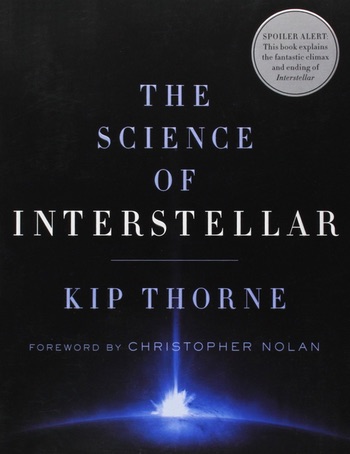Review: The Science of Interstellarby Jeff Foust
|
| “But most important to me,” Thorne writes, “was our vision for a blockbuster movie grounded from the outset in real science.” |
However, spoiler warnings have a statute of limitations. Surely any warnings about the film’s plot have expired by now, several months after its cinematic release, as the movie is already available for home viewing from some sources (like Amazon Instant Video) and will be released on DVD and Blu-Ray this week. If you haven’t seen Interstellar yet, you’re probably in no rush to do so now, and probably won’t be bothered by any spoilers that a book about the film’s science contains.
Kip Thorne, the Caltech theoretical physicist who is the author of The Science of Interstellar, served as the science advisor for the movie and was involved in it from the very beginning, when a friend of his, producer Lynda Obst, discussed with him the concept for a science fiction film she was considering. He signed on, thrilled to help shape what could become a major movie. “But most important to me,” he writes, “was our vision for a blockbuster movie grounded from the outset in real science.” (Emphasis in original.)
Thorne’s book is largely a discussion of the “real” science that served as the foundation for the movie. Thorne acknowledges that the movie stretched the boundaries of what is widely accepted in some areas, and highlights those topics that are “educated guesses” or “speculations,” the latter being defined as concepts that “spring from real science, from ideas that at least some ‘respectable’ scientists regard as possible.” Throughout the book, he uses a set of icons to identify those chapters or subsections that qualify as truth, educated guesses, or speculation.
Given the movie, and Thorne’s own background, much of the book deals with topics like black holes, wormholes, and the nature of spacetime. He is proud of the work by director Christopher Nolan and the movie’s visual effects team to provide an accurate depiction of a black hole, including its gravitational lensing properties and the appearance of its accretion disk. “Interstellar is the first Hollywood movie to depict a black hole correctly, in the manner that humans would actually see and experience it,” he writes.
Those visual effects, painstakingly crafted from calculations made by Thorne, offered scientific insight as well. Thorne describes in the book how he was “struggling to extract insights” from the high-resolution imagery the visual effects team produced. “For me, those film clips are like experimental data,” Thorne, a theorist, writes. That effort has recently led to the publication of a scientific paper by Thorne and the effects team, something that Thorne said in the book was in the works.
| “Interstellar is the first Hollywood movie to depict a black hole correctly, in the manner that humans would actually see and experience it,” Thorne writes. |
While Thorne illustrates those concepts with stills from the movie, he also dives deep into the science behind them, with scientific jargon to match, from tendex lines to branes. He makes no apologies for the level of detail: “Some segments of this book may be rough going. That’s the nature of real science. It requires thought. Sometimes deep thought.” You can skim through the densest parts of the discussions of singularities and additional dimensions and still gain a better appreciation of the science in the book.
While most of the book deals with physics and astronomy, the book also briefly touches on conditions on Earth, in particular the “blight” killing crops and providing the impetus to send humans through a wormhole looking for a new home. Biology is not Thorne’s specialty, but in one chapter he describes how he convened a group of Caltech biologists, including one Nobel laureate, to discuss over dinner how that blight might work. They concluded that such a blight was possible, but—good news!—it’s not very likely. That chapter was labeled with Thorne’s icon for speculation.
Separate from the science covered in the book is one chapter that covers the movie’s long development. Thorne was involved with the concept behind the movie starting in 2005, and saw many ups and downs in its development, including for a time having Steven Spielberg on board as director. He discusses working with the film’s eventual director, Christopher Nolan, who at times pushed against Thorne’s desire not to violate the known laws of physics, as well as the film’s major actors. It’s hardly a Hollywood tell-all, but instead a fun inside look at the making of the movie.
The spoiler warning on the cover of The Science of Interstellar is largely unnecessary: it makes more sense to see the movie first, before reading the book, since you have to appreciate the film and its various plot points to better understand the science behind them that Thorne describes. The film and the book demonstrate that it is possible to create a movie rigorously grounded in science; whether that allows for a good movie is another question. (Thorne, at one point in the book, notes that some scientific complexity he sought had to be left out since they were limited in what could be “absorbed in a fast-paced two-hour film.” Interstellar, in fact, ran closer to three hours, and to many viewers dragged on at times.) Perhaps, though, both the film and the accompanying science book will inspire some to learn more about the science at the boundaries of what is known today.
